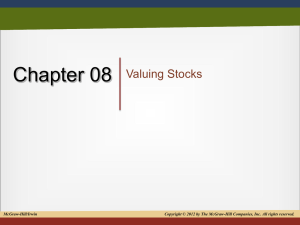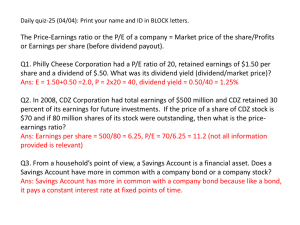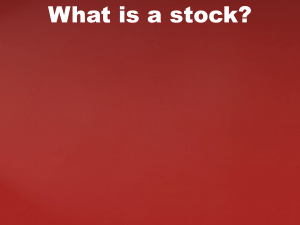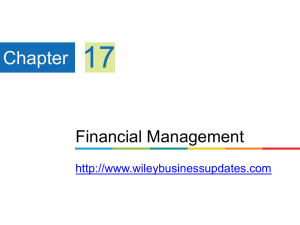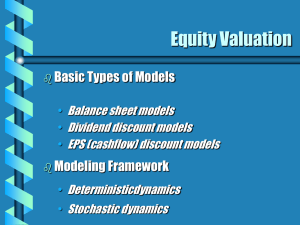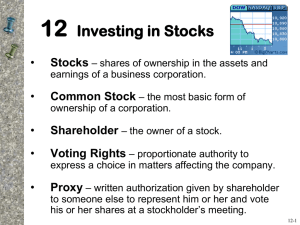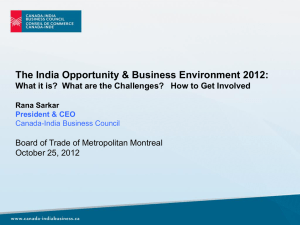Connection Between Dividends and Stock Values Equity Markets
advertisement
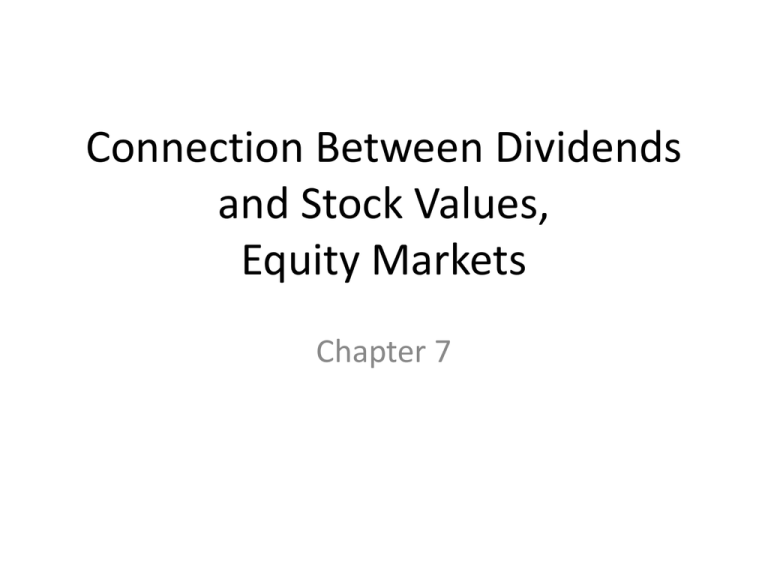
Connection Between Dividends and Stock Values, Equity Markets Chapter 7 Topics • Stock Value, Dividends And Dividend Growth • Some Features Of Common And Preferred Stocks • Different Ways Corporate Directors Are Elected To Office • Stock Markets Valuation of Stocks and Bonds • Stock cash flows are less certain than that of bond cash flows because: • Bond cash flows are fixed and defined by contract • Whereas stock cash flows are: • Dividends: residual and determined by the Board of Director’s vote • Proceeds from sale of stock: Not guaranteed • Difficulties in Stock Valuation: • Dividend cash flows are not known in advance • Life of stock is essentially forever • No easy way to observe the rate of return required for a stock Common Stock Valuation Cash Flows to Stockholders • If you buy a share of stock, you can receive cash in two ways The company pays dividends You sell your shares, either to another investor in the market or back to the company • For stocks with cash flows that are easily determined, the price of the stock is the present value of these expected cash flows 4 Stock Price Present Value Of Future Cash Flows Essentially Zero (Discounted Over Long time. Math Notation For Present Value Of All Future Dividends: D t ˆ P0 t t 1 (1 R ) Estimating Dividends: Special Cases • Constant dividend (Preferred Stock) The firm will pay a constant dividend forever This is like preferred stock The price is computed using the perpetuity formula • Constant dividend growth The firm will increase the dividend by a constant percent every period For most corporation this is an explicit goal. • Supernormal growth Dividend growth is not consistent initially, but settles down to constant growth eventually 7 Preferred Stock = Dividend With Zero Growth • An annuity in which the cash flow continues forever Equal cash flow goes on forever (like most preferred stock pays dividend) • “Capitalization of Income” PVAn i 1 - 1+ n = PMT* i n PMT PV = i n (n*x) As x gets large, (1+i/n) Approaches zero Constant Dividend (Zero Growth; Perpetuity) D P0 R P0 Current Stock Price D Constant Dividend Forever (PS) R = Required Return (Discount Rate) Preferred Stock Valuation (Example 1) • If you buy preferred stock that pays out a contractual yearly dividend of $5.50 and the appropriate discount rate is 12%, what is the stock worth? (What is the present value of this perpetuity?) $5.5/.12 = $45.83 Example 1.1 • Suppose stock is expected to pay a $0.50 dividend every quarter and the required return is 10% with quarterly compounding. What is the price? 0.50 P0 $20 .10 4 Dividend Growth Model • Dividends are expected to grow at a constant percent per period. P0 = D1 /(1+R) + D2 /(1+R)2 + D3 /(1+R)3 + … P0 = D0(1+g)/(1+R) + D0(1+g)2/(1+R)2 + D0(1+g)3/(1+R)3 + … With a little algebra, this reduces to: D0 (1 g) D1 P0 R -g R -g 12 Dividend Growth Model Math: ( 1 g ) Pˆ0 D0 t t 1 (1 R) ^ D0(1+g) P0 = R-g t D1 = R-g Dividend Growth Model (Example 2) • Suppose Big D, Inc. just paid a dividend of $.50. It is expected to increase its dividend by 2% per year. If the market requires a return of 15% on assets of this risk, how much should the stock be selling for? P0 = D0(1+g)/(R-g) P0 = $0.50(1+.02) / (.15 - .02) = $3.92 14 Dividend Growth Model (Example 3) • Suppose TB Pirates, Inc. is expected to pay a $2 dividend in one year. If the dividend is expected to grow at 5% per year and the required return is 20%, what is the price? P0 = D1/(R-g) P0 = $2 / (.2 - .05) = $13.33 Why isn’t the $2 in the numerator multiplied by (1.05) in this example? 15 Stock Price Sensitivity to Dividend Growth, g (Example 3) Current Stock Price Increases as the Constant Growth Rate Increases, D1 = $2.00 and R = 20.00% $250.00 Srock Price Constant Growth Rate Srock Price 0% $10.00 1% $10.53 2% $11.11 3% $11.76 4% $12.50 5% $13.33 6% $14.29 7% $15.38 8% $16.67 9% $18.18 10% $20.00 11% $22.22 12% $25.00 13% $28.57 14% $33.33 15% $40.00 $200.00 $150.00 $100.00 $50.00 $0.00 0% 5% 10% Constant Growth Rate 15% 20% Stock Price Sensitivity to Required Return, R (Example 3) 5.50% 6.00% 6.50% 7.00% 7.50% 8.00% 8.50% 9.00% 9.50% 10.00% 10.50% 11.00% 11.50% 12.00% 12.50% 13.00% Current Stock Price Decreases as the Rate Of Return Increases, D1 = $2.00 and g = 5.00% $500 Current Stock Price RRR Current Stock Price $400.00 $200.00 $133.33 $100.00 $80.00 $66.67 $57.14 $50.00 $44.44 $40.00 $36.36 $33.33 $30.77 $28.57 $26.67 $25.00 $400 $300 $200 $100 $0 5% 7% 9% 11% RRR 13% 15% 17% XYZ Company (Example 4) • XYZ Company is expected to pay a dividend of $5 next period and dividends are expected to grow at 5% per year. The required return is 15%. • What is the current price? P0 = D1/(R-g) P0 = $5 / (.15 - .05) = $50 If the stock is selling for $51, do we buy? If the stock is selling for $49, do we buy? 18 XYZ Company (Example 5) • What is the price expected to be in year 4 for XYZ Company stock? P4 = D1(1 + g)4 / (R – g) = D5 / (R – g) P4 = $5(1+.05)4 / (.15 - .05) = $60.78 or Next slide… 19 Notice in Example 5: 20 XYZ Company (Example 5) • What is the price expected to be in year 4? P4 = P0(1+g)4 P4 = $50(1+0.05)4 = $60.78 21 Solve for Implied Return 𝐷1 𝑃0 = 𝑅−𝑔 𝐷1 𝑅−𝑔 = 𝑃0 Dividend Yield (% Gained From Dividend Cash Flow) 𝐷1 𝑅= −𝑔 𝑃0 Capital Gain Yield (% that stock grows) Stock Return Has Two Components More about R in chapters 10 & 11 XYZ Company (Example 6) • Continuing the XYZ Company Example: • What is the implied return given the change in price during the four year period? R = D1/P0 + g $5/$50 + 0.05 = 0.10 + 0.05 10% + 5% = 15% 10% = Dividend Yield 5% Capital Gains Yield 23 Bond Vocabulary: • Current Yield = Annual Interest Payment/Closing Price Not equal to YTM (unless bond sells for par); it does not include the capital gain from discounted face value (principal) Premium Bond • CY >YTM Discount Bond • CY <YTM In all cases (Current Yield) + (Expected one-period capital gain/loss yield of the bond) must be equal to the YTM Yield • Dividend Yield and Current Yield are similar because both only show the % gain from the Dividend/Interest Payment – Capital Gain not included. Constant Growth Model Assumptions 1. 2. 3. 4. Dividend expected to grow at g forever Stock price expected to grow at g forever Expected dividend yield is constant Expected capital gains yield is constant and equal to g 5. Expected total return, R, must be > g 6. Expected total return (R): = expected dividend yield (DY) + expected growth rate (g) = dividend yield + g Non-constant Growth Problem (Example 7) • Suppose a firm is expected to increase dividends by 20% in one year and by 15% in two years. After that dividends will increase at a rate of 5% per year indefinitely. If the last dividend was $1 and the required return is 20%, what is the price of the stock? • Remember that we have to find the PV of all expected future cash flows. 27 Non-constant Growth – (Example 7) Solution • Compute the dividends until growth levels off D1 = $1(1.2) = $1.20 D2 = $ 1.20(1.15) = $1.38 D3 = $ 1.38(1.05) = $1.449 • Find the expected future price P2 = D3 / (R – g) = $ 1.449 / (.2 - .05) = $ 9.66 • Find the present value of the expected future cash flows P0 = $ 1.20 / (1.2) + ($ 1.38 + $ 9.66) / (1.2)2 = $ 8.67 28 Non-constant growth followed by constant growth: 0 rs=20% 1 2 g = 20% D0 = 1.00 g = 15% 1.20 1.38 3 g = 5% 1.449 1.0000 0.9583 6.7083 8.6667 = P0 ^ P2 = $1.449 = $9.66 0.20 – 0.05 Non-constant + Constant growth Pˆ 0 D1 D2 P2 1 2 2 1 R 1 R (1 R ) Because Dt P2 t ( 1 R ) t 3 If g constant after t 2, then D3 P2 Rg Other Methods Of Stock Valuations You Might See In An Advanced Accounting/Finance Class • • • • Pro Forma Financial Statements Present Value Of Free Cash Flows Residual Income Method Many more… Example 8 Stock Shares Outstanding Years for High Growth First 3 Year growth rate = g = After 3 years of high growth, g will drop to: Total Dividends just paid = Required Return = D1 D2 D3 D4 P3 Cash Flow Time 1 Cash Flow Time 2 Cash Flow Time 3 PV of Future Cash Flows Price Per Share RAD Co. 500,000 3 20.00% 5.00% $1,000,000.00 15.00% $1,200,000.00 $1,440,000.00 $1,728,000.00 $1,814,400.00 $18,144,000.00 $1,000,000.00*(1+0.2) $1,200,000.00*(1+0.2) $1,440,000.00*(1+0.2) $1,728,000.00*(1+0.05) D4/(R-g) $1,200,000.00 1 $1,440,000.00 2 $19,872,000.00 3 ($15,198,487.71) =PV(B7,C14,,B14)+PV(B7,C15,,B15)+PV(B7,C16,,B16) $30.40 =-B17/B2 Stocks and Bonds: • Like bonds, stocks bring capital (money) into the corporation so that it can invest in profitable projects Bondholders are creditors • They have a fixed claim to cash flow Stockholders are owners • They have a residual claim to cash flow • Assets = Liabilities + Equity Differences Between Debt and Equity • Debt Not an ownership interest Creditors do not have voting rights Interest is considered a cost of doing business and is tax deductible Creditors have legal recourse if interest or principal payments are missed Excess debt can lead to financial distress and bankruptcy • Equity Ownership interest Common stockholders vote for the board of directors and other issues Dividends are not considered a cost of doing business and are not tax deductible Dividends are not a liability of the firm and stockholders have no legal recourse if dividends are not paid An all equity firm can not go bankrupt Common Stock • Buy 1 stock Get to vote for Directors of corporation, who in turn decide what managers to hire. • Generally: 1 stock = 1 vote for each Director position on the Board of Directors. Get dividends (payouts to stockholder) when Board of Directors declares dividend. Claim to remaining assets in bankruptcy after creditors and preferred stockholders get their share. Features of Common Stock • Voting Rights Stockholders elect directors Cumulative voting • Directors are elected all at once (helps shareholders with a small number of shares) Straight voting • Directors elected 1 at a time (# shares > 50%, you can vote in all Directors) Proxy voting • Letting someone else vote for you Cumulative Voting Vs. Straight Voting Name Pham Omar Total Shares Outstanding = # Directors to be elected = N = # Shares 70 30 100 4 Cumulative Voting (Directors are elected all at once) Usually ==> Determine Total # of Votes For Each Stock Holder = (# of Shares)*(# of Directors) # of Shares Needed To Guarantee Yourself That You Get Elected = 1/(N+1)*(Total Shares Outstanding)+1 Total votes for Pham 280 Total votes for Omar Minimum # Shares Needed To Elect Yourself = Cast all votes for himself and he is 120 in 21.00 Straight Voting (Directors elected 1 at a time) Total votes for Pham 70 Total votes for Omar 30 Pham can elect all Directors because 70/100 = 0.7 > 50% The fewer seats up for election, the harder it is for a shareholder with a small number of shares to get elected. The more seats up for election, the easier it is for a shareholder with a small number of shares to get elected. Voting • Cumulative voting – when the directors are all elected at once. Total votes that each shareholder may cast equals the number of shares times the number of directors to be elected. In general, if N directors are to be elected, it takes 1 / (N+1) percent of the stock + 1 share to assure a deciding vote for one directorship. Good for getting minority shareholder representation on the board. • Straight (majority) voting – the directors are elected one at a time, and every share gets one vote. Good for freezing out minority shareholders. • Staggered elections – directors’ terms are rotated so they aren’t elected at the same time. This makes it harder for a minority to elect a director and complicates takeovers. • Proxy voting – grant of authority by a shareholder to someone else to vote his or her shares. A proxy fight is a struggle between management and outsiders for control of the board, waged by soliciting shareholders’ proxies. 38 Features of Common Stock • Classes of stock Many Different Types of Stock (Different contracts) Google • Founders want company to “Not Be Evil” and so they created a type of stock that gives them more voting rights. In this way they can control the direction of the firm and attempt to not “be evil”. Features of Common Stock • Other Rights present in many Com. Stocks: Share proportionally in declared dividends Share proportionally in remaining assets during liquidation Preemptive right • Right of first refusal to buy new stock issue to maintain proportional ownership if desired Vote on issues such as Mergers Dividend Characteristics • Dividends are not a liability of the firm until a dividend has been declared by the Board Consequently, a firm cannot go bankrupt for not declaring dividends • Dividends and Taxes Dividend payments are not considered a business expense, therefore, they are not tax deductible Dividends received by individuals are taxed as ordinary income Dividends received by corporations have a minimum 70%* exclusion from taxable income *IRS tax law provide up to 100% exclusion as the % ownership increases (as % increase, the corp. just outright owns the company…) 41 Features of Preferred Stock • Dividends: Stated dividend that must be paid before dividends can be paid to common stockholders. Dividends are not a liability of the firm and preferred dividends can be deferred indefinitely. Most preferred dividends are cumulative – any missed preferred dividends have to be paid before common dividends can be paid (arrearage). • Preferred stock generally does not carry voting rights. In some cases, if dividends are not paid, Preferred Stockholders are granted voting rights • In liquidation, they are only paid the “stated value” of the Preferred Stock. • Preferred Stock ½ Debt + ½ Equity. 42 Financial Markets • Primary Markets Original sale of equity or debt Corporation issues security (gets capital (cash)) • Secondary Markets After original sale of equity or debt You sell/buy security 43 Dealers vs. Brokers Dealer Think “Used car dealer”. Maintains an inventor of securities. Ready to buy or sell at anytime. Most debt is sold this way. Example: NASDAQ. Dealers buy and sell securities for themselves: • Bid = Price dealer willing to pay • Ask = Price dealer willing to sell • Spread = dealer profit = Ask - Bid Broker Think “Real estate broker” Brings buyers and sellers together Brokers and agents match buyers and sellers Most of the large firms’ equity is sold this way Example: NYSE New York Stock Exchange NYSE • In terms of $, Largest Stock Market in world. • Prior to 2006: 1,366 exchange members that own “seats” on the exchange and collectively were owners. Record price for seat was $4 M in 2004. • After 2006: NYSE became a public owned corporation: NYSE Group Inc. • Exchange members now purchase “trading licensee” (max # = 1,500) about $45,000. • “trading licensee” entitles you to buy and sell securities. New York Stock Exchange NTSE • 2007: NYSE and Euronext merged • 8 countries around world • USA, Belgium, France, Ireland, Netherlands, Luxembourg, Portugal, United Kingdom • Open 21 hours a day New York Stock Exchange NTSE • Watch NYSE in action: http://www.youtube.com/watch?v=ns7kfI_apwk • Specialist Dealer who stands at “station” and specializes in buying or selling a certain number of stocks. These “Market Makers” post the bid and ask prices. Function as “referee”. • Commission Brokers Broker who represent clients and either: • Buy / Sell from other Commission Brokers • Buy / Sell at bid / ask price from Specialist • Floor Brokers (Help Commission Brokers) • Floor Traders (Trade on their own accounts) • SuperDOT (allows orders to be transmitted electronically) NYSE Operations • Operational goal = attract order flow • NYSE Specialist: Assigned broker/dealer • Each stock has one assigned specialist • All trading in that stock occurs at the “specialist’s post” Trading takes place between customer orders placed with the specialists and “the crowd” “Crowd” = commission and floor brokers and traders NASDAQ National Association of Securities Dealers Automated Quotation • NASDAQ & OMX (merged 2007). • Large portion of technology stocks. • Computer-based quotation system where Dealers post price and # securities to trade to subscribers to NASDAQ. No physical location. • Multiple market makers (Dealers that buy and sell). • Three levels of information. Level 1 – real-time bid/ask quotes, but not who is bidding/asking or how many. Level 2 – real-time bid/ask quotes & who is bidding/asking & how many. Level 3 – Dealers can enter bid ask and other info. These are the market makers. ECNs • Electronic Communications Networks provide direct trading among investors • Developed in late 1990s • ECN orders transmitted to NASDAQ • Observe live trading online at Batstrading.com Reading Stock Quotes • What information is provided in the stock quote? Constant Dividend (Zero Growth; Perpetuity) D P0 R P0 Current Stock Price D Constant Dividend Forever (PS) R = Required Return (Discount Rate) 52 Calculate FV Of Current Dividend With Constant Growth Rate D t D 0 (1 g) t D 0 Current Dividend D t Dividend at period t t Periods g Constant Growth Rate Calculate Current Value Of Stock With Constant Growth Rate (Dividend Growth Model) D0 (1 g) D1 P0 R-g R-g P0 Current Stock Price D0 Current Dividend D1 Next Dividend g Constant Growth Rate R = Required Return (Discount Rate) As log as ==> g > R (otherwise stock price infinite) Growing Perpetuity (An Asset With Cash Flows That Grow At A Constant Rate Forever) C0 (1 g) C1 P0 R-g R-g P0 Current Asset Price C0 Current Cash Flow D1 Next Cash Flow g Constant Growth Rate R = Required Return (Discount Rate) As log as ==> g > R (otherwise stock price infinite) Calculate FV Of P0 (Price Of Stock At Time t) D t (1 g) D(t+1) Pt = R-g R-g Pt P0 (1 g )t t Periods P0 Current Stock Price Pt Price At Time t D t Dividend At Time t D(t+1) Dividend At Time t + 1 g Constant Growth Rate R = Required Return (Discount Rate) Rates • Dividend Yield D1 Dividend Yield P0 • Capital Gains Yield (Constant Growth Rate) Capital Gains Yield = g • Required Rate Of Return D1 R g P0

